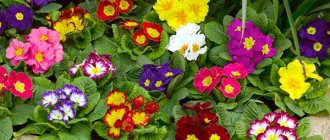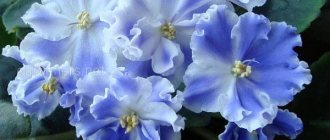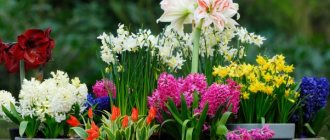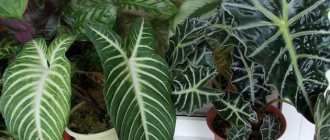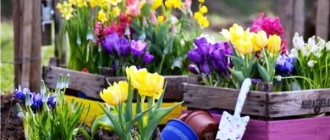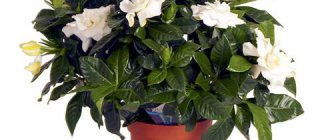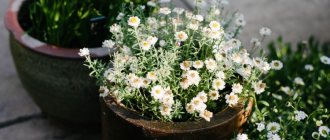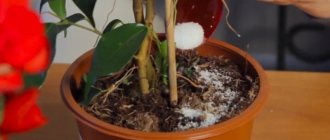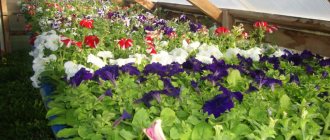Garden flowers perennials
Popular crops that can be found in almost all flower beds and gardens allow you to create a landscape design that will last for many years. In most cases, the most beautiful garden flowers, perennials, are easy to care for and resistant to low temperatures. There are plants that bloom in early spring, and there are those that will delight throughout the summer.
Early garden flowers perennials
If you want to enjoy flowers as the first warm days appear, plant bulbous plants such as snowdrops, crocuses, muscari or reticulated irises. In addition, there are other perennial early garden flowers:
- Hellebore.
It amazes with its variety of colors and early flowering. It is better to plant in spring, but in warm regions it can also be planted in autumn. The perennial flower is easy to care for and resistant to disease.
- Primrose.
Flowering can be observed already at the end of March, and it is abundant, and with proper care at the end of summer, the plant will delight you with the appearance of buds again. Can be grown in plots and in pots. They tolerate transplantation well.
- Periwinkle.
A perennial plant that retains green foliage even under snow, and flowers appear in April. They differ in color, and there are even terry specimens. They like moderately moist soil and shaded places.
Unpretentious garden flowers perennials
Many people plant crops to decorate their garden that do not require excessive care. There are excellent perennial garden flowers that do not require care:
- Lupine.
This plant is popularly considered a weed, but it is also very beautiful. Soil and special care are not important for him. It is better to plant a flower on the sunny side. If you cut off the faded “candles”, flowering will occur again.
- Garden chamomile.
A perennial flower that will decorate any flower bed. It will delight you with flowering for a long time, and it lasts for a long time when cut. Watering and fertilizing are carried out in the usual ways, without special conditions.
- Phloxes.
There is a wide range of colors and even “chameleons” that change the light according to the lighting. These perennial garden flowers can grow for up to eight years without care, but when the flowers begin to get smaller, you should fertilize them with organic matter.
Long-blooming perennial garden flowers
When thinking about decorating a site, many gardeners prefer to choose crops that can bloom for a long time. To their delight, there are many such plants, and here are popular perennial garden flowers that bloom all summer:
- Pansies.
If you plant summer varieties, you will be able to see bright colorful flowers until late autumn. It is worth noting resistance to heat and ease of care.
- Astilbe. This perennial garden flower is beautiful not only during flowering, but also before and after it. An excellent option for a rock garden. Loves partial shade, but is not fussy about care. The colors are very varied.
- Dianthus grass.
It grows in creeping bushes that can cover a large area. The flowers are small red. Flowering occurs from July to September.
- Large-flowered flax.
Popular species with red flowers. Although they live for one day, they change to new buds and this continues all summer and until October. Flax is fastidious, grows in any soil and tolerates drought well.
Garden shade-loving perennial flowers
Some crops do not grow well in the shade, and there are those that only need such conditions. Among those that do not bloom, the ideal option is hosta. There are other garden perennial flowers for shady places:
- Dicentra.
One of the most beautiful and original flowers that are easy to care for. It is important to plant in well-drained soil. Interestingly, the more shade there is on the site, the longer the flowering will continue.
- Forest bell.
These perennial garden flowers are used for flower beds, edgings and for decorating areas under trees.
- Badan.
Perennial plants have beautiful pink flowers that can decorate the site. Interestingly, after the snow melts, the leaves of this crop are healing.
Garden perennial flowers vines
You can decorate your site and buildings with the help of beautiful vines, among which are such popular flowers.
- Climbing rose.
The plant boasts long flowering, and the buds bloom only once. These perennial garden liana flowers love the sun, and in winter it is recommended to wrap them up.
- Ivy.
An unpretentious crop that can be grown even in Siberia. Dense foliage creates good shade, for which the branches should be tied in the right direction.
- Honeysuckle.
Some species of these plants have flowers and original foliage. At night, the open buds emit a pleasant aroma. For good flowering, it is better to plant in sandy and loamy soils. It is recommended to cover in winter.
Perennial garden tuberous flowers
A popular group of plants that are highly decorative, but they will have to be looked after. Common tuberous garden flowers:
- Corydalis.
The most popular species is the crested hollow. The bushes grow from 10 to 30 cm, and it is better to place them in shady places with loose forest soil.
- Gladiolus.
These are corms, presented in 200 species. They are distinguished by an erect stem with inflorescences and spikelets. These garden flowers come in different colors and may differ in flowering time and flower size.
- Crocosmia.
The bushes reach a height of 50-60 cm, and they should be planted in sunny areas protected from the wind. The soil should be rich and well-drained. In winter it needs to be covered.
Perennial bulbous garden flowers
This group contains interesting and beautiful plants that will delight you with their beautiful flowering. In most cases they are early. The most popular bulbous garden flowers perennials:
- Snowdrop.
The culture loves sunny places, but it is not picky about the soil. Flowering is observed throughout the month, but the bulbs should be planted in the fall.
- Crocuses.
Another common name is saffron. These perennial garden flowers come in different colors: yellow, purple, white, lilac and so on. Planting is carried out in the fall, and flowering occurs, like snowdrops, in March.
- Hyacinths.
The plants are known for their large inflorescences, which can be of different colors, for example, white, pink, burgundy, blue and so on. It is better to plant in shaded and protected places from the wind. Hyacinth does not like excessive moisture.
- Common bulbous flowers that are perennials include muscari, daffodils, reticulated iris and scillas.
The most beautiful perennial garden flowers
It is impossible to definitively answer which crops are the most beautiful, since everyone has their own taste. Therefore, in addition to the options described above, you can also offer these most beautiful garden flowers:
- Rose.
According to reviews, this is the most beautiful plant, which is presented in a wide range of colors. By selecting different varieties, you can get a flowerbed that will bloom throughout the summer and half of the fall.
- Lily.
A flower that can become a decoration for a flower bed, thanks to its large and colorful buds. It does not require maintenance and is resistant to pests.
- Peony.
Bushes with large and fragrant buds will decorate the area. This crop does not require special care. Peonies are easy to propagate.
Introduction
As such, the concept of “bulbous” does not exist in botany.
This word unites several dozen genera of plants cultivated by humans, mainly for decorative purposes, having a modified stem - a bulb. This is not a root tuber, like potatoes, and not a nodule, like legumes, used exclusively as storage of nutrients. The bulb is not just a repository of “building material”, it is like a miniature plant embryo. Three types of bulbous plants in a flowerbed
The presence of a bulb is most often characteristic of three families: Liliaceae, Amaryllis and Alliumceae. The first include the well-known lilies and tulips, the second - daffodils, irises and snowdrops, and the third - the various onions and garlics known to everyone. Recently, it has been believed that Alliums are a subfamily of Amaryllis, but gardeners, as a rule, do not go that deep into botany.
Most primroses are bulbous. Scilla or Scylla
The popularity of bulbous plants is explained by several important circumstances. Firstly, it is possible to constantly replant them with each new season. Since the plant enters a dormant period in winter, its bulb can be easily dug up and replanted without any fear of damage to the root system.
The second important condition that ensures the popularity of bulbs is the ability to adjust the time of their growth and flowering within a very wide range (almost all year). This process is called forcing; it is very convenient for obtaining flowers of certain plants by a certain date.
The third advantage of bulbous plants is their excellent ability for vegetative propagation, which allows them to obtain good quality seed material for several years in a row at no particular cost. As a rule, the degeneration of bulbous plants with exclusively vegetative propagation is about 5 to 10 years, which gives a fairly large margin of time when planning their replacement with other crops.
Bulbous in natural environment. Crocuses
Naturally, like any phenomenon, the use of bulbous plants has its drawbacks, which mainly come down to excessive depletion or even poisoning of the soils in which they are grown without crop rotation for several years.
Currently, there are a huge number of these plants that can decorate both any garden and the interior of any home due to the variety of their colors and shapes. The agricultural technology of most bulbous plants is quite simple. Growing them does not require any special skills or even technical means.
The greatest labor intensity when working with these plants is the work of replanting them or storing some heat-loving species in the winter. Other activities related to them practically do not require the gardener’s attention.
Most bulbous plants are of tropical or subtropical origin. Despite this, many plants in our climate thrive in open ground. They endure cold winters in a dormant state, sometimes withstanding frosts down to -30°C. Some species (crocuses, snowdrops) can tolerate temperatures down to -10...12°C during the active growing season. Let's look at the most popular types of bulbous plants.
Tuberous flowers
Tubers are shortened, modified underground shoots that acquire a conditionally spherical shape as a result of the growth of internodes. Tubers are usually formed at the ends of the lateral shoots of the rhizome - stolons. The tubers of some plants are edible, such as Jerusalem artichoke or potatoes.
Among the tuberous plants, the majority are herbaceous perennials, the ground part of which completely dies at the end of the season, but emerges from the growing point in the spring. During the season, the plant forms many tubers, so these crops have no problems with vegetative propagation. In cool climates, tubers overwintering in the ground need to be well covered, but if the winters in your area are really harsh, then it is better to dig up the underground part of the plant for the winter.
Among the decorative tuberous crops, gloriosa, sinningia, tuberose, caladium, smithiana, herbaceous peony, canna, anemone, begonia, diplodenia, delphinium, gesneria, dahlia, cyclamen, freesia and arrowroot are widely popular.
Tuberous plants do not tolerate acidic and too dense soils and require balanced watering. Before planting tubers, the area is fertilized with organic matter, and sand is placed in each hole for drainage.
Modified underground shoots: rhizome, tuber, bulb, corm.
Rhizome is an underground shoot of perennial herbs, subshrubs and shrubs. Externally, the rhizome is similar to the root, but differs from it in its horizontal location in the soil, the presence of scale-like leaves, scars from fallen buds and adventitious roots. An apical bud develops at the top of the rhizome, and axillary buds develop in the axils of the scales. From the buds of the rhizome, above-ground shoots develop annually, dying off in the fall. The internal structure of the rhizome is typically stem. Most often, the rhizome is an organ of vegetative propagation, and in a number of plants (water lily, lily of the valley) it serves as a storage place for nutrients.
A tuber is a modified shoot with a very thickened stem in which nutrients are stored. They appear as thickenings on a thin underground shoot - the stolon. The place where the tuber attaches to the stolon is called its base. The tuber has apical and lateral buds - eyes. Tubers are formed in plants such as potatoes and Jerusalem artichokes. They perform a storage function and are organs of vegetative reproduction.
The bulb is a short underground shoot with succulent leaves attached to a short stem - the bottom.
At the top of the bottom there is an apical bud, in the axils of the succulent scales there are lateral buds, giving rise to young baby bulbs. The succulent scales store reserve nutrients. The outside of the bulb is often covered with dry scales that play a protective role. Bulbs are formed in onions, lilies, garlic, and tulips.
The corm is similar in appearance to an onion, but differs from it in its highly overgrown bottom, where nutrients are stored. On top it is covered with dry filmy leaves. The corm has well-developed apical and axillary buds, giving rise to flowering shoots and baby corms. Corms are formed in colchicum, gladiolus, and saffron.
Fig.27. A-rhizome: 1-lily of the valley, 2-wheatgrass; B-potato tubers, B-bulbs: 1-onion, 2-lily-saranka, 3-tulip; G-crocus corm.
Sheet
A leaf is a lateral vegetative organ growing from a stem, having bilateral symmetry and a growth zone at the base. Main functions of the sheet:
- depot of reserve nutrients;
-organ of vegetative reproduction.
The leaves of most plants have a petiole and a leaf blade. Leaves that do not have a petiole are called sessile.
Leaves can be simple or compound. Simple leaves have one leaf blade. A compound leaf consists of several leaf blades attached to a common petiole using their own petioles.
Fig.28. The leaves are simple and complex: 1-lilac, 2-apple, 3-maple, 4-clover, 5-dandelion, 6-rosehip, 7-raspberry, 8-strawberry, 9-lupine.
The leaves are arranged on the stem in a certain order. Leaf arrangement
there are three types: regular
— one leaf per stem node (birch, poplar);
opposite
- two leaves extend from the node, located opposite each other (maple, lilac);
whorled
- at least three leaves extend from the node (bamboo).
Fig.29. Leaf arrangement: 1 - alternate; 2-opposite; 3- whorled
In addition, leaves differ in the type of venation. Veins
- These are vascular-fibrous bundles, clearly visible on the leaf blade. They perform mechanical and conductive functions. There are three main types of venation: reticulate, parallel and arcuate. Reticulate venation
subdivided into
pinnate:
smaller ones extend from the main vein (oak, aspen);
and palmate:
the main veins extend from the base of the leaf blade (maple).
Such venation is more common in dicotyledonous plants. For monocotyledonous plants, parallel
veining is more typical: the veins are located parallel to each other (wheat, corn);
and arcuate
- the veins are arranged in the form of arcs (lily of the valley).
Anemones - planting and care in the garden
Author: Marina Chaika February 27, 2022 Garden plants
It doesn’t matter how your love for anemones began - from a gifted bouquet or admiring a neighbor’s flowerbed - this flower knows how to make you fall in love with it at first sight!
So that your passion for this bright beauty does not turn into a dreary burden, be sure to familiarize yourself with the requirements of this flower sissy for care, watering, soil, lighting and delicacies... Are you hungry yet? Then catch the first life hack on anemones: the capriciousness of this flower depends... on the variety! If you are not yet ready to pay a lot of attention to the flower you like, just choose a “more accommodating” anemone.
How not to get lost in the fascinating, but such a huge (today there are about 160 species!) assortment of anemones? How to choose an unpretentious or, on the contrary, the most “complex” anemone? How not to confuse the summer anemone with the autumn one, and even less fuss with the mandatory annual freezing of seeds - we’ll tell you right now.
Dahlias: growing from seeds and tubers
Author: Marina Chaika February 18, 2022 Garden plants
Did you know that 90% of your success in growing dahlias in full bloom depends on how you... store them?
In second place is the right soil. Gardeners look for signs of disease or pests, but the most common cause of death of first or transplanted dahlias is unsuitable soil. Yes, dahlias can heroically withstand changes in acidity, but good soil permeability is vital for this plant. If the site you have chosen cannot boast of such, this can be easily corrected. When digging the soil in the autumn, add a little ash, peat, humus, sand to the soil, and add chopped straw.
It will also be useful to spread straws in the spring, after planting the tubers. It will help retain precious moisture and save you from unnecessary work on loosening the soil.
Read more tips and secrets for growing your favorite dahlias in our article.
Possible problems during cultivation
In order for tuberous plants to please with their appearance, they must be properly cared for. Improper care can lead to:
- gray rot and powdery mildew affect tuberous plants with excessive moisture
- with a lack of nutrients in the soil, plants become stretched and thin, and flowers lose color saturation
- if watering is excessive, the tubers are affected by mold, rot and fungal diseases
- with a lack of light, plants slow down and their leaves turn yellow
- When the air is dry, the leaves curl and dry out.
Tuberous plants have won the favor of gardeners due to their decorative properties and ease of care. Many species do not require annual replanting and add variety to the flower garden or decorate the windowsill. By adhering to simple rules, you can achieve unprecedented success, and the variety of species gives you the opportunity to choose and fantasize.
More information can be found in the video:
Irises: growing in open ground
Author: Marina Chaika February 27, 2022 Garden plants
Iris means “rainbow” in Greek. Today this rainbow has more than 700 shades and 35 thousand varieties! But it’s not just the colorful and delicate colors of the cockerels that captivated us: perfumers all over the world value irises for their unique bright aroma.
Did you know that bearded irises are more drought tolerant than their beardless counterparts? That the orris root popular among traditional healers, confectioners and perfumers is actually the root of irises?
We will tell you about these and other secrets of iris in our article.
Why do some irises have no scent? How to save iris from slugs without using chemicals? Do irises need to be covered for the winter? How to prune iris bushes correctly and beautifully after flowering? Why don’t cockerels want to bloom even on “ideal” soil and watering?
Callas - growing at home and in the garden
Author: Marina Chaika February 09, 2022 Garden plants
The homeland of calla lilies is South Africa. In this part of the world, calla lilies are called a relative of gladiolus. In Europe, the “Ethiopian beauty” appeared in the 17th century, and the exotic flower was grown as a houseplant.
Nowadays, calla lilies decorate not only many window sills, but also terraces, loggias, and gardens.
Moreover, it became known that guests from the African continent have unique endurance: even with changes in lighting, temperature or humidity, callas continue to bloom!
In our latitudes, callas bloom from early summer until late autumn, and each “flower” lives for about a month. If you provide the plant with proper care, each bush will have 10-12 inflorescences.
Read about the intricacies of caring for indoor and garden callas in our material.
Features of asexual reproduction
In nature, angiosperm species reproduce asexually. Plants have learned to adapt to unfavorable conditions, and they do not reproduce in the same way. Options by which the asexual formation of daughter specimens occurs in nature and during cultural cultivation:
- disputes;
- shoots;
- cuttings;
- layering;
- root growth;
- tubers;
- creeping mustache;
- thalli or body pieces (in algae);
- bulbs;
- air bulbs;
- leaves;
- roots.
Gardeners and flower growers choose those methods that have a high survival rate and allow them to obtain offspring with minimal labor and time.
When selecting, they use special diagrams and tables compiled by research institute employees. A part of a plant is considered a separate organism from the moment when it can independently carry out life processes.
The plant obtained as a result of separation has the same species and varietal characteristics as the parent. It can be considered a clone. The advantage of such propagation is the accelerated development of a seedling, flower or bush compared to growing from seeds. Fruit or vegetable crops form generative buds earlier and yield faster.
Indoor and garden plants grown from tubers, shoots or leaves better tolerate adverse factors and suffer less from diseases and pests. In addition, when reproducing from seeds, it is not always possible to preserve varietal characteristics, but as a result of cloning they remain unchanged.
Tuberous flowers: photos and names
Tuberous flowers are available in a wide variety of varieties. On this page you can see photos and names of tuberous flowers for growing in the garden.
ANEMONE, ANEMONE - ANEMONE
- Flowering time: March - April
- Location: sunny or slightly shady
- Reproduction: division in summer
Tuberous varieties are grown from rhizomes or tubers. Chamomile anemones have a yellow core and narrow petals - a popular species is A. blanda, 15 cm high. Poppy anemones have poppy-like simple or double flowers. Usually grown varieties of A. coronaria with a height of 15-30 cm.
BEGONIA TUBER - BEGONIA
- Flowering time: June - September
- Location: Lightly shady is best
- Reproduction: planting sprouted tubers
The most famous is tuberous begonia (B. tuberhybrida) with pink-shaped flowers 5-15 cm in diameter. Begonia multiflora (B. multiflora), 20 cm high, has numerous smaller flowers. Drooping begonia (B. pendula) with stems 30-60 cm long is suitable for hanging baskets. Water well in dry weather.
CROCOSMIA, MONTBRETIA - CROCOSMIA
- Flowering time: July - August
- Location: best sunny
- Propagation: A plant grown for flower arranging and for color in the border. Arching flower stalks bear tubular or star-shaped flowers above sword-shaped leaves.
Common crocosmia (C. crocosmiflora), 60 cm high, has numerous hybrids. The red-flowered 'Lucifer' is hardy, but some like the semi-cold-hardy yellow 'Solfaterre'.
Lily
Garden flowers that bloom all summer: photos and names
These elegant flowers will survive 4-5 years without replanting and, depending on the variety, will bloom from June to September. If you want to achieve earlier flowering, plant the bulbs in August-September, deepening them 7-15 cm into the ground. This procedure can be postponed until April-May, but the flowering period of the lily will shift.
Lilies
Before purchasing planting material, I recommend reading the important information in the publication What do the mysterious codes in the names of lilies mean? Features of growing different hybrids. And then on your site there will be exactly those plants that can bloom and develop well.
Corm garden flowers and their photos
The most famous corm garden flowers are crocuses and their varieties. Next you can look at the photo of corm flowers, which are easily grown and propagated in various conditions.
CROCUS, SAFFRON – CROCUS
- Flowering time: depends on the variety
- Location: sunny or slightly shady
- Reproduction: division in autumn
There are four groups of this bulbous plant.
Dutch hybrids with large flowers (bloom in spring), hybrids of golden-flowered crocus (C. chrysanthus) with medium flowers (bloom in spring), early-blooming species with small flowers (bloom in early spring) and autumn-blooming species with small flowers.
Tuberous perennial flowers
The selection includes a variety of perennial tuberous flowers, including lilies and daylilies, peonies, daffodils and many other species. We suggest you consider tuberous perennial flowers such as spring flowers and gladiolus.
VESENNIK – ERANTHIS
- Flowering time: February - March
- Location: sunny or partial shade
- Reproduction: division in June
Glossy yellow flowers begin to appear at the same time as snowdrops - each flower has a frilly green "collar". Leaves appear later.
The most popular species is the winter springweed (E. hyemalis), 10 cm high, which can cause trouble by self-sowing. Tubergen's spring grass (E. tubergenii) is sturdier and less aggressive.
GLADIOLUS - GLADIOLUS
- Flowering time: July – September
- Location: best sunny
- Reproduction: corms - children after digging
There are many types with peduncle heights ranging from 30 cm to 1.2 m. Large-flowered hybrids are the most popular group - corms are planted in the spring and dug up in October for indoor storage.
There are also Primulinus, Butterfly and Miniature hybrids with a height of 45-60 cm.
Tuberous perennials: corydalis, gladiolus, crocosmia
Perennial flowers for the sunny side.
garden flowers - basic rules. garden plants that love the sun. beautiful sun-loving perennials. daisies and chrysanthemums Corydalis (CORYDALIS). Smokey family.
Perennial tuberous corydalis are mostly short (10-30 cm) tuber-bearing plants that grow in temperate deciduous forests. The leaves are green, often bluish, appear in early spring and die off by the end of May, i.e. these are typical ephemeroids. The flowers are collected in a cluster at the top of the stem, bloom in May, bear fruit in June, and self-sow.
Types and varieties:
More often than other species, the corydalis
(C. cava)
with delicate, repeatedly divided leaves and lilac flowers.
Marshall's Corydalis
(C. marchalliana)
has mostly creamy yellow flowers.
Haller's Corydalis
(C. halleri)
- pinkish-purple flowers.
Corydalis
(C. bracteata)
- large light yellow flowers.
Growing conditions.
Shady places with loose forest soils.
Reproduction.
Seeds (sow freshly harvested) and tubers. Planting at the end of summer to a depth of 5-7 cm. Planting density - 25 pcs. per 1 m2.
Shady areas are suitable, among shade-loving herbs, in “natural garden” plantings.
Gladiolus, swordweed (GLADIOLUS). Iris family.
The name comes from the Latin gladus - “sword” and is given by the shape of the leaves of this plant. There are about 200 species in the genus, all of them bulbous. The corm is flattened and lives for one season. It is renewed due to tuber-onion-children.
Perennials with sword-shaped leaves, an erect stem bearing at the top an inflorescence-spike with 10-30 funnel-shaped flowers.
Thousands of varieties of these tuberous plants are known, but they are divided into 5 groups:
- by flower size
(giant - flower diameter is more than 14 cm, large-flowered - 11-13 cm, medium - 9-11 cm, small - 6-9 cm, miniature - less than 6 cm); - According to color, varieties are divided into 13 classes
(white, green, yellow, orange, salmon, salmon pink, red, crimson, pink-lilac, purple, chestnut, smoky, brown); - According to the flowering period
, early (blooming from the end of July), medium (from mid-August), late (from the end of August) are distinguished. One peduncle blooms for about 10 days.
According to the arrangement of flowers in the inflorescence, groups are distinguished: single-row, double-row, alternate, double-sided, spiral.
Pay attention to the photo of these tuberous flowers: gladioli, among other things, also differ in the shape of the petals: they can be simple, corrugated, folded and dissected. Types and varieties:
Types and varieties:
The hybrid gladiolus
(G. xhybridus)
, which is mainly grown by gardeners, is the result of complex hybridization involving African species. Gladiolus species of temperate flora are rarely used, as they have small, quickly fading flowers.
But species such as tiled gladiolus
(G. imbricatus)
can be used in “natural garden” flower beds.
These tuberous garden flowers are best grown in individual beds. But lower varieties can be used in mixborders.
Crocosmia, montbretia (CROCOSMIA=MONTBRETIA). Iris family.
They are perennial tuberous flowers with narrow sword-shaped leaves and funnel-shaped orange-yellow flowers. Height 50-60 cm. In central Russia, mainly cultivars are grown. They have small (2 cm) corms that form numerous underground stolons, and on them are young plants.
Known varieties:
"Star of the East"
- with pale-orange flowers.
"Chees Madgest"
- with orange-scarlet flowers.
"Citronella"
- lemon yellow flowers.
Growing conditions.
Sunny areas protected from the wind with loose, rich, well-drained soils. For the winter, it is necessary to cover with spruce branches or fallen leaves of oak, maple; it is possible to use a thin non-woven covering material.
Reproduction.
Seeds, children - in the spring. Seedlings bloom in the 3rd year. Planting density – 16 pcs. per 1 m2.
Perennial flowers - all varieties (130 photos). Planting, growing and caring for the site with your own hands
A beautiful flower garden without unnecessary hassle is the dream of any avid summer resident who puts a lot of effort into other areas of his farm. A skillful combination of plants according to flowering times will allow you to enjoy the beauty of the flowerbed throughout the working season. Using perennial garden flowers will protect you from problems with annual planting.
If you choose unpretentious and long-blooming specimens, the task will be simplified as much as possible. You need to take care of compliance with the above parameters in advance, so you can start studying the necessary information in the winter.
Brief contents of the article:
How to properly equip a flowerbed with plants
A beautiful all-season flower garden is created taking into account the competent selection of plants according to:
- height;
- flowering time;
- color of buds.
The tallest specimens are placed in the center of the composition. So, they will not interfere with the view or limit the “rights” of neighbors. Based on flowering time, you can choose “long-lasting” varieties or successfully arrange a change in order.
The coloring of adjacent buds should not disturb the existing harmony. You can create a flower garden in a single color scheme or work out a specific color solution.
The organization of a flower bed is often carried out according to the “troika” principle. For each flowering period there should be at least 3 plants in the active phase. Those who are afraid of making mistakes in their calculations are advised to pay attention to perennials with a long period of bud retention.
Long-blooming flowers are always held in high esteem by thrifty owners. Purchasing such options will save your budget and precious time.
Before purchasing, you should carefully study the information about the species proposed for planting. Any plant can have nuances of growth in certain conditions (territorial and climatic features are taken into account).
Height distribution: important points for proper planning
In most cases, tall flowers are planted separately in accordance with the landscape design. They look great near buildings, against a fence or as a hedge.
To create an organized flower garden, such plants are used in limited quantities. They will become an excellent background (if the flowerbed is adjacent to the building) or will attract attention if the site is located separately.
Tall plants are placed in such a way that they do not obscure the light from the rest of the composition, and also so that they do not interfere with the view of the whole ensemble. Long flowering options are preferred. Tall stems (from 50 cm to 2 m) with large single flowers, lush inflorescences or panicles will give the flowerbed a festive accent.
Medium-sized options will create the impression of a smooth transition from tall to short plants. It is recommended to select varieties with long flowering. By promptly removing wilted buds, you will be able to maintain harmony in the flowerbed. Unpretentious flowers will be the right solution.
Low-growing residents are always located near the borders of the flower garden. Depending on the owner’s preferences, they can occupy up to 2/3 of the entire area. “Lilliputians” are most often placed in rows depending on the color of the corollas.
A schematic arrangement is also possible (if the flowerbed layout has a complex structure). In some cases, gardeners deliberately mix seeds when planting. This way, you can achieve unique diversity.
In addition to connecting the plants in a flowerbed by height, do not forget about the compatibility of other important conditions (relationship to light, moisture, soil type).
Escape modifications
Tuber and rhizome are modifications of above-ground organs. There is nothing surprising about this. Despite their location underground, they have all the parts of a shoot in their structure. Examples of these are tubers, bulbs, rhizomes, tendrils and tendrils. Each of them has its own structural features that determine their functions. For example, strawberry tendrils are necessary for vegetative propagation. Although it produces flowers and seeds, this method is the most essential. But the mustache of the grape is needed to attach its vines to the support.
The bulbs will be returned to the ground next spring. Tuberose is well known for its perfumes. This beautiful Mexican woman will only enjoy outdoor space in the gardens of privileged areas, otherwise a greenhouse or veranda crop will be preferred.
Tuberose, one of the most fragrant flowers
Tuberose is a native of Mexico. It grows spontaneously in sparse forests, along roadsides or in sandy areas. Tuberose is widely used in perfumery because its aroma is powerful. It is also the origin of several famous perfumes. Long cultivated in Grasse for the perfume industry, India has now taken over the bulk of world production.
A leek or garlic bulb consists of a flat stem called a stem. Adventitious roots are attached to it. They grow in bunches. This is a typical structure for At the bottom there are also buds and several types of leaves. Some of them are juicy and meaty. They store water and nutrients. Others are dry and dense, serving as additional protection from mechanical damage and excessive transpiration. Young green leaves periodically grow from the buds located on the bottom. They are commonly called green onions. All of the listed structural features once again prove that the bulb is a modification of the shoot.
Tuber cultivation conditions
Plant tuberose in the garden in May, when any risk of frost extends. Choose the sunniest spot to plant your tuber in the garden. The soil must be very drained, even sandy, but also very rich, two parameters that are sometimes difficult to combine. Before planting, drain the soil and add well-decomposed manure and compost to the soil to enrich it. In the pot, select a large container and line the bottom of the pot with a layer of clay balls. Place the tuber about 10cm deep in a mixture of good quality soil, garden soil and compost.
Choosing a variety: the difficulties of seasonal matching of components
To properly plant a flower garden, you need to know the names of the perennial flowers that are preferred for planting for seasonal replacement of empty space. There are no specimens that are in continuous bloom from May to October. Therefore, the task of competent planting planning is to equip the space as efficiently as possible.
With the arrival of spring, primroses emerge from under the snow. These are crocuses, tulips, daffodils, lilies of the valley, periwinkle, pushkinia, hyacinth, primrose. Most of them are compact in size. Flowering is usually short-lived. You can choose different combinations with variable “rule” from late April to mid-June.
Among the beautiful and unpretentious perennials of the mid-season, there are many options that do not require replanting for up to 10 years. Many of them have not only gorgeous flowering, but also an equally attractive green mass.
Correctly selected combinations will help the flower bed remain in the spotlight all season long. Popular among gardeners are: astilbe, loosestrife, geranium, cornflower, carnation, iris, lupine, poppy.
Autumn is not a reason to forget about the surrounding beauty. The annuals that are fading in the flower beds are being replaced by no less attractive, bright and fragrant “replacers”. Phloxes or perennial asters are able to delight with their lush flowering until frost.
Looking at photos of perennial flowers will help you make your choice. By comparing the visual picture with the characteristics of the plant, you will be able to understand which options are most suitable.
Botanical description and characteristics
Begonia is an extensive genus of plants from the Begoniaceae family, consisting of approximately 1,600 species. Habitat: tropics of Asia, Africa, South America. About 125 species are grown as potted, container or indoor plants, and there are more than 2000 varieties, their number increasing annually.
Begonia masoniana
Among the representatives of the genus there are annual or perennial herbs, shrubs and subshrubs, and climbing vines. Some species amaze the imagination with incredible beauty with leaves, others with flowers. The third ones do not look as impressive as the first two groups, but they can easily win a place on the windowsill from other indoor plants.
Indoor begonia can have a varied appearance; it’s easy to choose a plant to suit every taste:
- leaves - from plain to decorated with incredible patterns, small or large, smooth or covered with hairs;
- flowers - tiny and inconspicuous, or spectacular, bright, large.
Sometimes it's hard to believe that such different plants belong to the same genus. But there are a number of unifying features:
- vegetative organs are juicy;
- leaves are asymmetrical;
- the central vein divides the plate into two unequal parts;
- unisexual flowers;
- corollas of irregular shape.
Types and varieties
There is no single classification of domestic begonia. Species can differ greatly in appearance, require special conditions of maintenance, and be difficult or relatively easy to care for.
Blooming begonia
Attracts attention with lush flowering, opens buds throughout the growing season. The petals are simple or double, the color is often pink, red, white, but can be any color except blue, cyan, violet, sometimes a combination
Everblooming begonia
There are four groups:
- Everblooming (Begonia semperflorens) is grown as an annual or perennial crop. Plant height is from 8 to 30 cm, the leaves are green or brownish, small. The diameter of simple flowers is up to 5 cm; new buds appear continuously from spring to autumn.
- Tuberous begonia - varieties and hybrids with a pronounced dormant period. The corollas are terry or simple, up to 5 cm, rarely exceeding 10 cm in cross-section.
- Lorrain (Begonia x Lorrain) is a series of winter-flowering hybrids up to half a meter high with rounded leaves and graceful curved shoots. Petals in one row, diameter up to 2.5 cm.
- Elatior or Riger (Begonia x Elatior) is a series of hybrids that blooms regardless of the season. Corollas up to 5 cm, terry or simple.
Decorative foliage begonia
The most beautiful, capricious, difficult to care for begonia for the home. The main decorative value is the large, original shape and color of the plate.
The most spectacular species need to be grown in a florarium; they simply will not survive on a windowsill:
- Imperial (Begonia imperialis) is distinguished by plates up to 10 cm, the front side is silver, decorated with dark green strokes, the back side is red;
- Royal or Rex (Begonia rex) has leaves similar to elephant ears, color - from steel to all shades of purple;
- Mason (Begonia masoniana) - emerald plates, in the center there is a large, Maltese-like, black cross.
Variety Merry Christmas
A little easier to care for:
- Bauer;
- Hogweed;
- Fista.
Begonia bush
A group of scrubs. The plants grow quickly, are relatively easy to care for, form attractive upright or semi-spreading bushes, and often bloom beautifully.
Fuchsia begonia
Common types:
- Spotted;
- Bright red;
- Fuchsia.
Reed begonia
The Cane group or Angel Wings (Cane-like begonias) are mainly interspecific hybrids. Begonia aconitifolia took part in the creation of many.
It is distinguished by strong, straight shoots with thickenings at the nodes.
Useful and harmful properties
Begonia is one of the plants that most effectively purifies the air from volatile chemical compounds. Culture:
- releases phytoncides;
- improves mood;
- the juice is used to treat wounds and burns;
- helps with insect bites.
Flower garden without hassle: features of caring for perennials
Most of the perennials do not require complex care. However, you still have to give the plants minimal attention. This is the only way to enjoy the result without wasting precious time during the “hot” season.
Flowers with tubers or bulbs (tulips, gladioli, dahlias) must be dug up in a timely manner, as well as ensure proper storage and subsequent planting. Bulbous plants tolerate wintering in open ground, but for tuberous plants this is detrimental.
To get the expected flowering, the inhabitants of the flowerbeds will sometimes have to be looked after: loosened, mulched, fertilized, watered. In this case, it is necessary to take into account the characteristics of each resident of the flowerbed, especially if they are in close proximity.
Some perennials that do not require digging up for the winter need to be provided with decent shelter. Before planting a new type of plant, you should read the care recommendations in detail.
Timely collection of seeds, division, and propagation will preserve the variety and prevent it from degenerating. Regular replanting and pruning of the plant will have a beneficial effect on health and appearance.
A flower garden made up of unpretentious, long-flowering perennials can give a lot of joy without requiring special attention. The main thing is to plan the flower bed correctly, choose a suitable place for each plant and provide it with the necessary growing conditions.
New bulbous perennials
Every year, gardeners become acquainted with new perennials, introducing them into their landscape compositions. Corydalis, crocosmia, tigridia, montbretia, arizema, simplocarpus, chionodoxa, galtonia - these are not the names of distant planets and constellations, but of tuberous and bulbous perennials! From all the variety, any summer resident can choose a perennial for his flower garden that is suitable in design, conditions and personal preferences. Bulbous plants can play the role of a leader in a flower bed, or they can be an equal companion to other flowering and ornamental plants.
Perennials will allow you to create a flowerbed for several years to come, which will save the owner energy and money. Perennials can grow in place for 3-4 years without replanting. Over time, they reproduce independently, daughter bulbs form on the bulbs, the tubers grow and can be divided, all this makes it possible to increase the planting of your favorite flowers without additional costs.
Specifics of tuberous flowers
The tuber system of the plant is represented by a modified shoot, which has a cylindrical or spherical shape. They develop on the lateral shoots of the rhizome and are able to accumulate water and minerals. When caring for and growing plants with such a root system, the following recommendations should be taken into account:
- tubers do not tolerate high acidity of the soil, which leads to deformation and stopping their development;
- it is important to follow the watering regime to avoid fungal and bacterial infections;
- fertilizers are usually applied at the time of planting; unscheduled fertilizing is required only in case of illness or slow growth;
- the soil for growing should be light and drained, since the active formation of new tubers requires a lot of air;
- when grown in cold regions, the plant can be dug up for the winter;
- There is no need to trim the bush after flowering; the leaves and peduncles turn yellow and fall to the ground before dormancy begins.
Tubers tolerate long-term storage in a dry substrate (sand, sawdust or moss). For the winter, they can be put away in a cellar or basement, and then propagated and planted in a new place.
Feeding is important!
Fertilization is a necessary condition for plants of any kind. This also applies to tuberous begonia, which requires systematic feeding when planting and caring for it. You need to start it during early planting. During this period, nitrogen fertilizers are best suited, the elements of which stimulate shoot growth and stop the onset of flowering. The amount of such substances should not exceed the norm specified in the instructions. Otherwise, the onset of the flowering period will be greatly delayed, and the shoot will become “fat.”
Begonia develops and blooms well in soil that is rich in organic matter. If the plant is wilting, there may be a lot of lime in the substrate. Organic and mineral fertilizing should be alternated with an interval of 2 weeks. Systematic application of fertilizers begins from the moment of transplantation and ends with flowering. Approximately this period lasts from May to October.
Plants for the garden
Garden tuberous plants are represented by a wide variety and species diversity. This group includes primroses, crops with a medium and late growing season. They are resilient, but require special attention when growing and caring for them.
Anemone
Among flower growers, this plant is better known as “anemone”, since the petals begin to flutter even with minimal exposure to wind. This is a low-growing herbaceous shrub of the Ranunculaceae family. Forms a powerful rhizome with cylindrical tubers. The height of the stem varies from 30 to 70 cm. The leaves are formed on long petioles and have a dissected shape.
Flowers can be single or collected in umbellate inflorescences. Depending on the variety, the petals are white, purple or pink. The formation of flowers begins in early spring and lasts up to 2 months, then they form a hazel-shaped fruit with a characteristic pubescent surface.
Dahlia
A multi-species genus of flowering plants in the Asteraceae family. It is actively used in gardening, often used in landscape design for planting as a tapeworm, in group compositions. It is distinguished by the large size of its flowers and the variety of colors and textures of its petals.
Depending on the variety, the stem can grow to a height of up to 2.5 m. It forms powerful and fleshy tubers that tolerate division well. Dahlias begin to bloom in mid-summer and remain decorative until the end of the season. The plant is grown as a perennial crop; replanting to a new location is required every 5-8 years.
Gladiolus (Skewer)
A perennial of the Iris family, most species grow in Africa. The root system is represented by a round corm, which is actively growing and developing. Depending on the varietal group, the height of the stem varies from 50 to 150 cm. The leaves are very thin and have a characteristic sword-shaped shape.
Gladioli gained their popularity thanks to their decorative flowers. It is collected in a long spike-shaped inflorescence, growing up to 80 cm in height. The buds are funnel-shaped, the petals have a simple or terry texture. Interesting varieties of swords:
- Lace swirl;
- Moon trail;
- Magic of color;
- Oscar;
- First grader.
Gladiolus has high vitality and quickly adapts to the climate and soil composition. Some gardeners dig up tubers after flowering to store them indoors, which reduces the risk of plant death.
Crocosmia (Montbrecia)
Decorative flowering crop for growing in the garden. The plant has been actively used in landscape design since the late 19th century; in some regions it is called “Japanese gladiolus.” Forms a powerful bush up to 100 cm high. The root system is represented by large corms in the shape of a cluster. The leaves are collected in a basal rosette, have a sword-shaped shape, and often their surface is corrugated. Paniculate inflorescences develop in mid-summer and remain attractive until September.
Each flower is shaped like a five-pointed star; the petals can be curved back. Depending on the variety, their diameter varies from 2 to 5 cm, the buds are usually colored red, yellow or orange. Crocosmia looks best as part of a group planting or in a mixborder in the background. It does not tolerate darkening and increased acidity of the soil, which is important to consider when choosing a location for a flower bed.
Replanting begonias
Young specimens need a new pot every year, adults and beautifully flowering ones - every 2-3 seasons. The operation is performed in the spring for all begonias, except for the Lorrain and Elatior hybrids - they should be planted in fresh soil by the end of summer or beginning of autumn, before the first buds appear.
Soil for begonias
The substrate must have a neutral reaction, be permeable, and maintain structure. For plants, a ready-made store-bought mixture based on Begonia peat is suitable. The soil is made independently from pre-treated components:
- leaf soil - 2 parts;
- garden - 1;
- turf – 1;
- coarse sand – 0.3.
Choosing a pot
The shape and volume of the container depend on the type of begonia:
- decorative leaves need low and wide ones - in deep ones the rhizome will not master the lower part of the substrate, it will turn sour;
- beautifully flowering - of a regular shape, but tight, otherwise the beginning of the buds will be delayed until the begonia has entwined the entire clump;
- Kanes and scrubs are not so demanding; standard pots are suitable for them, the size of which is increased by 2-3 cm with each transplant;
- For tuberous begonias, low bowls with a diameter of 10-15 cm are recommended - this way the soil does not become acidified, a lump quickly becomes entwined, and the flower throws out buds.
Seedlings or cuttings must first be planted in containers of 5-6 cm. During the first 2-3 years they are increased by one and a half times, then by 2-3 cm for most species. Growing decorative deciduous begonia requires that the diameter of the new container will exceed the previous one by 4-5 cm.
Planting tuberous species
In the spring, the tubers are removed from storage, exposed to light directly in the old substrate, and watering and temperature are increased. Dormant buds will quickly wake up and sprouts will appear.
Only then is the begonia taken out of the soil, sand or sawdust, inspected, if necessary, cleaned, and the wounds are powdered with fungicide or ash. The same should be done when dividing the tuber.
Drainage, a layer of coal, then a substrate are placed in the pot. Begonias are planted with their sprouts facing up. The tuber is dug in so that the part facing outward is only slightly sprinkled with soil. Watered.
Transplanting bush species
Plants try to move over without destroying the coma. Old soil is shaken off only as a last resort, if the root rots or the substrate is damaged:
- Place drainage, a layer of coals, and a little fresh soil at the bottom of the pot.
- A begonia with a lump is placed in the center, the stem is buried 2-3 cm.
- Fill and compact the substrate on the sides.
- Water with a root formation stimulator.
The first time after transplantation, the plant should be shaded more than usual. As soon as the bush begins to grow, a new leaf appears, the pot is moved to a permanent place.
Household tuberous plants
Tuberous plants are also found among potted crops. When growing them, you should remember that the root system requires a spacious container, which directly affects the growth rate. This botanical feature allows propagation by dividing the rhizome, and also simplifies the watering regime.
Hemanthus
A small genus of flowering plants in the Amaryllidaceae family. Some varieties are used as indoor and greenhouse crops. The name is derived from the Greek words “blood” and “flower”, due to the color of the buds. The root system has the shape of a pear-shaped tuber and may protrude slightly above the soil surface.
The belt-shaped leaves are very short and fleshy. The flowers are collected in a powerful umbellate inflorescence, which is surrounded by an ovoid bract. At home, you can achieve the formation of a fruit in the shape of a round berry with black seeds inside. Only hybrid forms of hemanthus are usually found on sale, but classic species are also grown in nurseries. The most popular of them:
The plant is not suitable for beginners. Requires careful adherence to watering, humidity and lighting regimes. Hemanthus is sensitive to temperature conditions and soil composition.
Amaryllis
A perennial flowering plant, the genus includes only one species - amaryllis belladonna. The first description of this culture was given by K. Linnaeus in 1753; today many varieties and hybrids have been bred for growing indoors. Forms a single corm with a diameter of up to 12 cm. Linear leaves grow up to 60 cm in length and are highly sensitive to humidity.
In the warm season, 1-2 peduncles are formed on the plant, on which funnel-shaped buds are located. They can be colored white, red, pink or purple. Hybrids with terry multicolor petals look especially decorative. Amaryllis can be grown in a separate pot or in a group composition in a box.
Zamioculcas (Dollar Tree)
One of the most popular decorative foliage plants for landscaping an apartment or office. Belongs to the Araceae family and grows wild in the tropical forests of Africa. Active selection of Zamioculcas began at the beginning of the 20th century. The root system is very powerful and forms many tubers. The stem grows slowly, the shoots are fleshy and dense. The glossy leaves are dark green in color and have a slight thickening at the base.
Flowering at home is very difficult to achieve; the flower is represented by an inconspicuous ear of a light cream color. For growing at home, hybrids are usually used that are resilient and unpretentious. All parts of the dollar tree are poisonous; the sap causes irritation and redness of the skin.
Gloxinia
A tropical plant named after a German doctor. The genus includes only 4 species, some of them are suitable for growing indoors. It is a perennial tuberous plant that produces short shoots. The bright green leaves have a velvety texture and react negatively to exposure to water. Flowering is possible almost throughout the warm season. Bell-shaped flowers, depending on the variety, can be simple or double. They are colored red, purple or white. Among flower growers, varieties with two-tone petals or a complex pattern on their surface are especially popular.
What is a tuber
A tuber is usually called a thickened and modified root - an underground stem shoot of some plants. It has dormant buds, usually with one or more internodes (for example, like potatoes or Jerusalem artichokes), or a dense subcotyledon (a prominent representative is cyclamen).
Tuberous plants are represented by a wide variety of species, but the largest group is represented by flowers, among which there are perennials and annuals, indoor and wild specimens. In addition, tuberous plants can be divided into types based on the characteristics of the underground part. Here they usually talk about root tubers and corms.
